Growing coriander
Growing coriander is a cinch; it comes up like a weed. The first spring you will scatter the seeds, or young plants from the nursery to give you a head-start. In autumn it produces a head of beautiful white flowers and next season tiny sprigs shoot up by the dozen.
It looks very similar to flat-leafed parsley, but the taste is quite different. Some folk dislike it, and that is okay.
Green-coriander is known as cilantro or dhania.
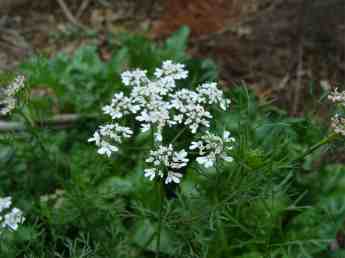
- Bernard Preston homepage
- Herbs Spices
- Growing Coriander
This page was updated on 4th October, 2020.
Coming originally from the Mediterranean area, it is today grown all over the planet; probably one of the world's favourite herbs. You can either enjoy coriander green in a salad or grind the dried-seeds for meat dishes, curries and stews.
Fresh from the garden, I make a mixed green salad almost every day using lettuce, rocket and coriander, for example. Tabbouleh is equally a favourite. In order to get my ten coloured-foods every day I add as many as possible. Each has its own subtle flavours, all with different phytochemical benefits.
Your greens are particular rich in vitamin B6 which, along with B12, prevents the build up of toxic homocysteine; it also helps reduce premenstrual-tension apparently.
Growing Coriander
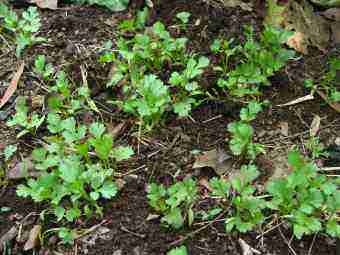
Growing coriander is just the easiest of all the herbs to plant and enjoy; it loves full-sun, but in midsummer tends to go to seed quite quickly. Afternoon shade is not a bad thing.
Sow the tiny-seeds directly in the ground, in a row if you like, or just sprinkle them around.
Plan on a patch because they seed themselves and next year will spring up in an ever-expanding area; a bit of a weed problem, but very easy to control.
Cover the seed with fine-soil and keep it moist. Once established it's hardy and requires little attention.
Top off the heads if it goes to seed, and let the plant become bushier.
Can you see in the photograph above the profusion of seedlings coming up at the foot of the mother-plant?
- Bernard Preston homepage
- Herbs Spices
- Growing Coriander
You will have to weed them very carefully initially. There will be a lot of competition coming up with your tiny coriander-plants.
The phytochemicals in many herbs, including coriander, have a preservative effect; it is the antioxidant in them. More important these are the foods that mop up the free-radicals that cause tumours.
One of these is a bioflavonoid called kaempferol; it is found in many greens and has potent anti-tumour properties. Scientists are looking at turning it into a drug for treatment.
That will be at great cost no doubt; alternatively we could just enjoy our greens daily.
Green coriander, or cilantro, itself goes off quite quickly; I am reluctant to buy it from the grocer. And why should one when it grows like a weed in your own garden? One could chop it up and freeze the fronds in an airtight container for a few months; that is a good idea in autumn when for a short season it is in profusion.
As I write it's spring and it is still in profusion.
We have dug out a patch of lawn, and instead grow herbs and spices; they are really so pretty and less grass to mow also.
The whole plant is edible, even the roots and stems; they could be used in a curry paste for example. But coriander seed and the green cilantro leaves taste quite different.
Store the seed whole in an airtight bottle, and roast gently when wanting to use it; then whir them in a coffee grinder dedicated to herbs and spices for a moment. It is wonderful in any stew or curry.
My spring herb patch has jalapenos, coriander, and chives; parsley and sweet-basil too. Right now the new plants are still small but already there are snippets in our lettuce side dishes. With a huge scoop of homemade hummus, every salad is a delight; unfortunately I am going to have to wait for the peppers and chilies. I love the kick they give to any meal and, after citrus, they are the richest source of vitamin C.
Here is an update on our coriander page; it is late summer and I was a bit depressed as the lovely cilantro was over; so I sprinkled some seed from last year on the early, roughened the earth and surrounded it with sticks to keep the hens out. Hey presto, there are about fifty tiny plants about an inch high. Within a week we will be enjoying sprigs in our salad again.
Cilantro
Obviously it has different names; often it is called Chinese parsley, but in South Africa we call it dhania. That is because of the large number of Indians living here. In Spanish it is known as cilantro; would a rose smell any different if you gave it another name?
Actually it loses its scent with cooking, so I tend to add it as a raw garnish, or just before the dish comes off the heat.
Talking of heat, have you heard of these counter-top induction stoves? They are quicker than gas and use half the electricity of a conventional spiral plate.
A garnish of coriander leaves on our Mexican avocado soup is a delight; spice up your cooking with these herbs that are so easy to grow.
Coriander benefits
Coriander benefits, for me at least, in the main are the character that it brings to a perhaps rather dull green salad.
But then it is also one more coloured food that you can chalk up on your way to our declared goal of ten for the day. More fibre will keep your colon happy, and some time I will do some homework on the phytochemicals that make it unique. Frankly anything related to parsley must be good.
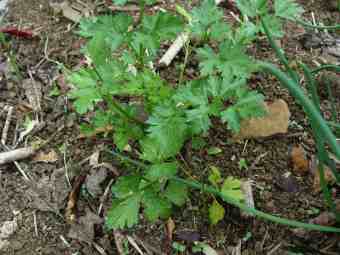
Collecting coriander seed
Collecting coriander seed is not difficult; just gather up the fronds once they have dried off, but before the seed has started falling.
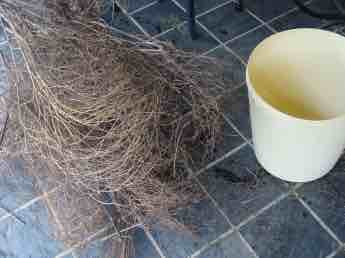
Run your hands down the fronds into a large bucket and just look, you have enough seed for the whole year. Growing coriander is so easy and rewarding.
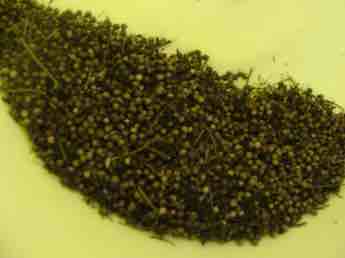
The seed above is quite dirty with dust and small bits of the plant; this honey-filter gets rid of most of the junk. Now for that chicken curry.
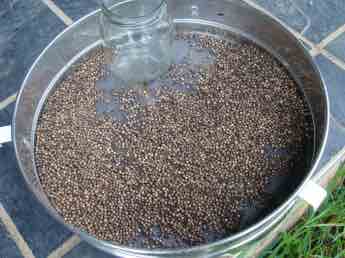
Phytochemical Foods
Phytochemical foods have the colours that prevent neoplastic disease; enjoy your butternut and beetroot, kale and spinach; tomatoes and radish too. And of course it is a good reason for growing coriander.
Newsletter
Our newsletter is entitled "create a cyan zone" at your home, preserving both yourself and Mother Earth for future generations; and the family too, of course. We promise not to spam you with daily emails promoting various products. You may get an occasional nudge to buy one of my books.
Here are the back issues.
- Lifestyle and ideal body weight
- What are ultra-processed foods?
- Investing in long-term health
- Diseases from plastic exposure
- Intensive lifestyle management for obesity has limited value
- A world largely devoid of Parkinson's Disease
- The impact of friendly bacteria in the tum on the prevention of cancer
- There's a hole in the bucket
- Everyone is talking about weight loss drugs
- Pull the sweet tooth
- If you suffer from heartburn plant a susu
- Refined maize meal and stunting
- Should agriculture and industry get priority for water and electricity?
- Nature is calling
- Mill your own flour
- Bake your own sourdough bread
- Microplastics from our water
- Alternative types of water storage
- Wear your clothes out
- Comfort foods
- Create a bee-friendly environment
- Go to bed slightly hungry
- Keep bees
- Blue zone folk are religious
- Reduce plastic waste
- Family is important
- What can go in compost?
- Grow broad beans for longevity
- Harvest and store sunshine
- Blue zone exercise
- Harvest and store your rainwater
- Create a cyan zone at your home
In the spring can cheat a little by buying a few seedlings; basically you are buying time, unless you have a hothouse and grow your own in late winter.
This little plant, one of six that we bought, is only two weeks in the ground and already we are enjoying a few sprigs of coriander benefits in our salads.
Our avocados are in season; later this morning I am going to make our famous Mexican avocado soup that is garnished with cilantro, call it what you like. It is particularly good if you are banting, because it is very high in fat, but has zero carbs; the best way to lose weight.
Plants capture the light, turning it into the incredibly varied phytochemical foods that our bodies desperately crave.
- Mexican avocado soup with coriander.
Perfect banting breakfast
The perfect banting breakfast is hard to come by; it needs to be very low in carbohydrate, yet high in protein and fat. Keep processed meat like bacon for high and holy days. Plenty of organic greens is part of the deal; growing coriander is dead easy because it seeds itself and from the shop goes awfully slimy.
With more than double the people on our planet dying from the ravages of obesity, compared with starvation, your coriander sprinkled at the last moment on eggs Florentine makes the perfect Banting breakfast if you are concerned about your weight.
- Banting diet; find it by using the site search function above.
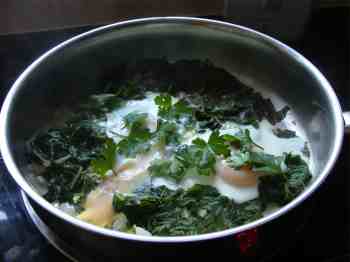
Since we are not obese, we enjoy it on a half slice of our low GI bread toast; butter is back, of course.
You cannot see it, but this pan is on the induction stove; they are delight to cook with. They provide instant heat. Growing coriander is so easy, and will add flavour and protection against tumours from the kaempferol to any dish[1].
Eggs Florentine
Eggs Florentine makes the most wonderful and versatile breakfast; add chilli and garlic and, if you have only a mild weight problem, read BMI closer to 25 than 30, then you can enjoy it on half a slice of toast; we always used mixed greens so growing coriander is just a plus.
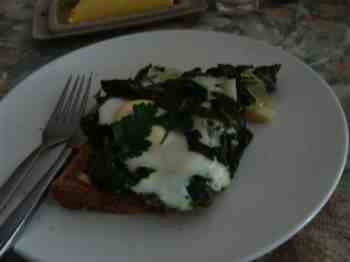
It is takes literally only a few minutes to mix the ingredients for our heavenly low GI bread dough; then you wait five-hours, tantalised by the most incredible aroma if you add herbs like coriander.
We add extra protein and fat to lower the GI of our bread. I wonder what a handful of our growing coriander leaves would taste like in the loaf?
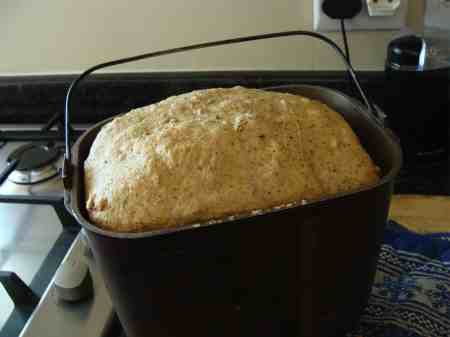
Some folk are concerned about salmonella infection from eggs; it is a serious cause of food-poisoning. Researchers have found that coriander contains an antibacterial compound called dodecenal which is twice as potent as the most commonly used drug gentamicin for fighting the bug.
In Europe there is an explosion of diabetes occurring in all ages; researchers have found that given to diabetic mice, coriander lowers blood sugar and stimulates the pancreas to produce more insulin.
In short coriander is a wonderful herb adding both flavour and important health-benefits to your food.
Green leafy salads
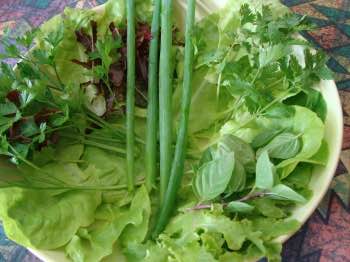
If you know how to grow your own rocket, for example, and other herbs such as sweet-basil then you can make up the most interesting green leafy salads.
Sadly these days a salad is often just lettuce and tomato, and it's often limp and old, or instead of greens chefs are using refined carbs; it is a tragedy making us fat instead of keeping us willowy and healthy.
Let's get back to growing our own vegetables, and a wide array of them; greens for your eyes' sake or you may go blind and get cataracts.
- Easy lunch recipes.
- Phytochemical Foods.
- Homocysteine cardiovascular - B9, B12 and choline vitamins are part of the solution.
- Recipe for tabouli tabouleh; find it using the site search function below.
- Induction cooktop stoves
Copy and paste "tabouli tabouleh" into Site Search in the main menu for more information.
When browsing use right click and "Open Link in New Tab" or you may get a bad gateway signal.
Did you find this page interesting? How about forwarding it to a friendly book or food junkie? Better still, a social media tick would help.
- Bernard Preston homepage
- Herbs Spices
- Growing Coriander
Address:
56 Groenekloof Rd,
Hilton, KZN
South Africa
Website:
https://www.bernard-preston.com